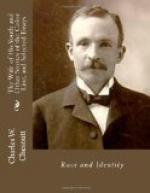The Indian will fade into the white population as soon as he chooses, and in the United States proper the slender Indian strain will ere long leave no trace discoverable by anyone but the anthropological expert. In New Mexico and Central America, on the contrary, the chances seem to be that the Indian will first absorb the non-indigenous elements, unless, which is not unlikely, European immigration shall increase the white contingent.
The Negro element remains, then, the only one which seems likely to present any difficulty of assimilation. The main obstacle that retards the absorption of the Negro into the general population is the apparently intense prejudice against color which prevails in the United States. This prejudice loses much of its importance, however, when it is borne in mind that it is almost purely local and does not exist in quite the same form anywhere else in the world, except among the Boers of South Africa, where it prevails in an even more aggravated form; and, as I shall endeavor to show, this prejudice in the United States is more apparent than real, and is a caste prejudice which is merely accentuated by differences of race. At present, however, I wish to consider it merely as a deterrent to amalgamation.
This prejudice finds forcible expression in the laws which prevail in all the Southern States, without exception, forbidding the intermarriage of white persons and persons of color—these last being generally defined within certain degrees. While it is evident that such laws alone will not prevent the intermingling of races, which goes merrily on in spite of them, it is equally apparent that this placing of mixed marriages beyond the pale of the law is a powerful deterrent to any honest or dignified amalgamation. Add to this legal restriction, which is enforced by severe penalties, the social odium accruing to the white party to such a union, and it may safely be predicted that so long as present conditions prevail in the South, there will be little marrying or giving in marriage between persons of different race. So ferocious is this sentiment against intermarriage, that in a recent Missouri case, where a colored man ran away with and married a young white woman, the man was pursued by a “posse”—a word which is rapidly being debased from its proper meaning by its use in the attempt to dignify the character of lawless Southern mobs—and shot to death; the woman was tried and convicted of the “crime” of “miscegenation”—another honest word which the South degrades along with the Negro.




